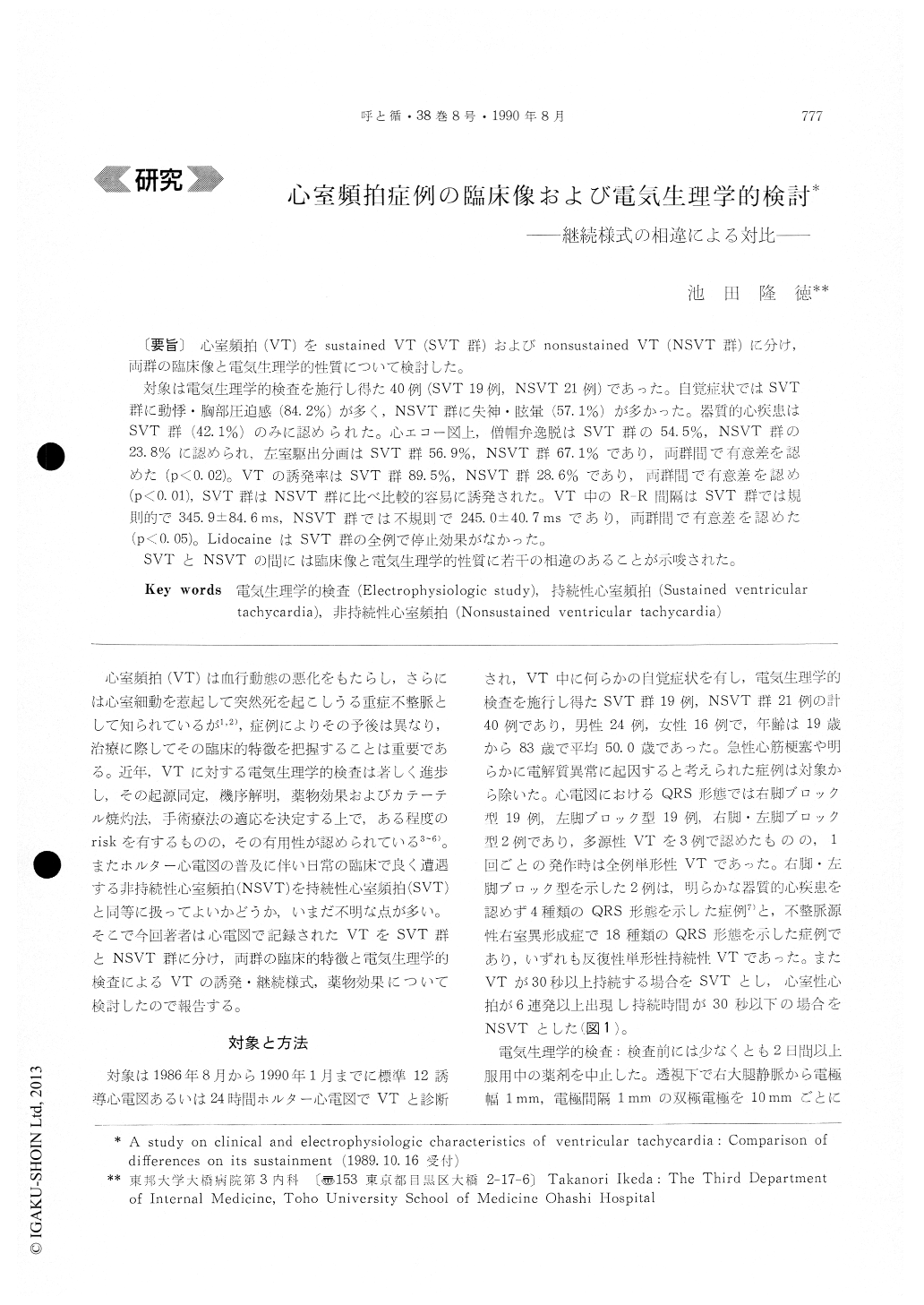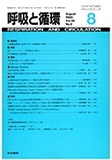Japanese
English
- 有料閲覧
- Abstract 文献概要
- 1ページ目 Look Inside
心室頻拍(VT)をsustained VT(SVT群)およびnonsustained VT(NSVT群)に分け,両群の臨床像と電気生理学的性質について検討した。
対象は電気生理学的検査を施行し得た40例(SVT 19例,NSVT 21例)であった。自覚症状ではSVT群に動悸・胸部圧迫感(84.2%)が多く,NSVT群に失神・眩暈(57.1%)が多かった。器質的心疾患はSVT群(42.1%)のみに認められた。心エコー図上,僧帽弁逸脱はSVT群の54.5%,NSVT群の23.8%に認められ,左室駆出分画はSVT群56.9%,NSVT群67.1%であり,両群間で有意差を認めた(p<0.02)。VTの誘発率はSVT群89.5%,NSVT群28.6%であり,両群間で有意差を認め(p<0.01),SVT群はNSVT群に比べ比較的容易に誘発された。VT中のR-R間隔はSVT群では規則的で345.9±84.6ms,NSVT群では不規則で245.0±40.7msであり,両群間で有意差を認めた(p<0.05)。LidocaineはSVT群の全例で停止効果がなかった。
SVTとNSVTの間には臨床像と電気生理学的性質に若干の相違のあることが示唆された。
The purpose of this study was to clarify the differ-ence of clinical and electrophysiologic characteristics between sustained ventricular tachycardia (SVT) and nonsustained ventricular tachycardia (NSVT).
40 patients consisting of 24 males and 16 females with an average age of 50.0 years (range from 19 to 83), who had shown ventricular tachycardia (VT) on electrocardiogram, were studied consecutively. The patients were divided into SVT group (19 cases) and NSVT group (21 cases). Ventricular stimulation was performed up to triple extrastimuli, and ventricular burst pacing was used when required. After VT was induced, R-R interval during VT was measured and an antiarrhythmic agent was given by bolus in-jection. Echocardiography was used for measure-ment of left ventricular ejection fraction (EF) and for evaluation of mitral valve prolapse (MVP).
Palpitation and oppressive sensation were domin-ant in SVT (84.2%), while dizziness and syncope were prominent in NSVT (57.1%). Organic heart disease (OHD) was observed in only 42.1% of SVT, and in none of NSVT.
MVP was observed in 6 patients of SVT and in 5 patients of NSVT. EF was significantly higher in NSVT (67.1%) than in SVT (56.9%) (p<0.02), while it was not significantly different in cases of NSVT and SVT where OHD was not present (64.4 %). VT was induced and sustained in 17 out of 19 patients (89.5%) in SVT by ventricular stimulation. In NSVT, VT was induced in 6 of 21 patients (38.6 %), but it was not sustained in any of them. The induction of VT in NSVT appeared to require more extrastimuli than in SVT. The R-R interval in SVT was longer than in NSVT (345.9?}84.6msec and 245.0?}40.7msec, p<0.05). The termination of VT by a class Ib antiarrhythmic agent was achieved in none of the 17 cases with SVT. On the other hand, VT was prevented by Ib in 3 of 6 cases with NSVT.
I conclude that some differences between both gro-ups may exist in clinical symptoms, EF, induction of VT, R-R interval during VT and efficacy of antiar-rhythmic drugs.

Copyright © 1990, Igaku-Shoin Ltd. All rights reserved.


